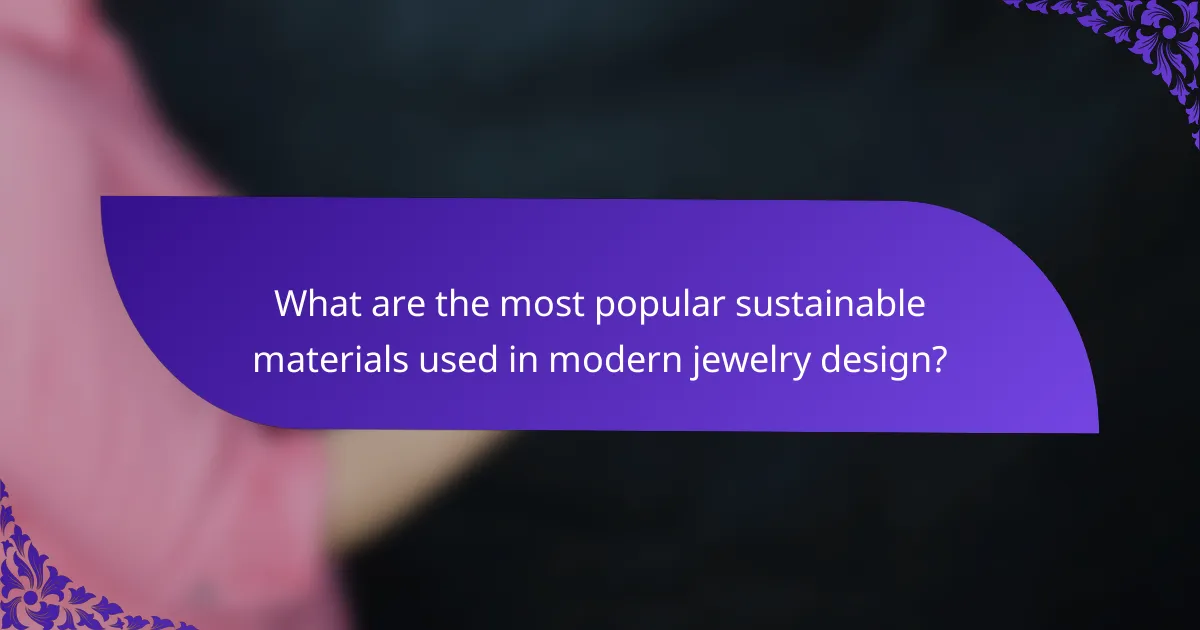Sustainable materials in modern jewelry design refer to eco-friendly resources utilized to create jewelry with minimal environmental impact. Key materials include recycled metals, ethically sourced gemstones, lab-grown gemstones, and organic materials such as wood and biodegradable plastics. These materials not only reduce the need for mining and promote fair labor practices but also cater to the increasing consumer demand for responsible fashion choices. The article highlights the benefits of incorporating these sustainable materials, emphasizing their role in minimizing waste and enhancing ethical sourcing practices within the jewelry industry.

What are Sustainable Materials in Modern Jewelry Design?
Sustainable materials in modern jewelry design are eco-friendly resources used to create jewelry with minimal environmental impact. These materials include recycled metals, ethically sourced gemstones, and organic materials like wood or bamboo. Recycled metals reduce the need for mining, which can harm ecosystems. Ethically sourced gemstones ensure fair labor practices and minimal environmental disruption. Organic materials offer biodegradable options, enhancing sustainability. The use of these materials aligns with a growing consumer demand for responsible and sustainable fashion choices. According to a 2021 survey by McKinsey, 67% of consumers consider sustainability when making luxury purchases.
How do sustainable materials differ from traditional materials in jewelry design?
Sustainable materials differ from traditional materials in jewelry design primarily in their sourcing and environmental impact. Sustainable materials are often derived from recycled or ethically sourced resources. This reduces the ecological footprint associated with mining and production. Traditional materials, like mined gold and diamonds, often contribute to environmental degradation and unethical labor practices. For instance, the mining of gold can result in habitat destruction and pollution. In contrast, sustainable alternatives, such as lab-created gemstones, minimize these harmful effects. Additionally, sustainable materials often promote circular economy principles by encouraging recycling and reuse. This contrasts with traditional materials, which typically follow a linear model of extraction and disposal.
What are the environmental impacts of traditional jewelry materials?
Traditional jewelry materials often have significant environmental impacts. Mining for precious metals like gold and silver leads to habitat destruction. It also causes soil erosion and water pollution from toxic chemicals used in extraction processes. The production of gemstones can result in similar ecological damage. For example, diamond mining often displaces local communities and disrupts ecosystems. Furthermore, the carbon footprint associated with transporting these materials globally contributes to climate change. According to the World Gold Council, gold mining can produce up to 1.5 tons of waste for every ounce of gold extracted. These factors underscore the urgent need for sustainable alternatives in jewelry design.
Why is sustainability important in the jewelry industry?
Sustainability is important in the jewelry industry to reduce environmental impact and promote ethical practices. The extraction of precious metals and gemstones often leads to significant ecological damage. For example, mining can result in deforestation, habitat destruction, and soil erosion. Additionally, unethical labor practices are prevalent in some regions, including child labor and unsafe working conditions. Sustainable practices help ensure that materials are sourced responsibly. According to the World Gold Council, sustainable gold mining can reduce carbon emissions by up to 40%. Consumers increasingly prefer brands that demonstrate commitment to sustainability. This shift influences market trends and encourages more companies to adopt eco-friendly practices.
What are the key benefits of using sustainable materials in jewelry design?
Sustainable materials in jewelry design offer several key benefits. They reduce environmental impact by minimizing resource depletion and pollution. Sustainable materials often come from renewable sources, ensuring long-term availability. Using recycled metals decreases the need for mining, which can harm ecosystems. Additionally, sustainable practices enhance brand reputation and attract eco-conscious consumers. Studies show that 66% of global consumers are willing to pay more for sustainable brands. Sustainable jewelry can also promote ethical labor practices, ensuring fair wages and safe working conditions. Overall, these benefits contribute to a more responsible and ethical jewelry industry.
How do sustainable materials contribute to ethical sourcing?
Sustainable materials contribute to ethical sourcing by minimizing environmental impact and promoting social responsibility. These materials often come from renewable sources, reducing the depletion of non-renewable resources. For example, recycled metals and ethically sourced gemstones lessen the demand for mining, which can harm ecosystems. Additionally, sustainable materials often support fair labor practices. This ensures that workers involved in the extraction and production processes are treated fairly and compensated adequately. Studies show that using sustainable materials can significantly reduce carbon footprints and enhance transparency in supply chains. This approach aligns with consumer demand for responsible products, fostering a more ethical marketplace.
What economic advantages do sustainable materials offer to jewelry designers?
Sustainable materials provide significant economic advantages to jewelry designers. They often reduce costs associated with sourcing and production. For instance, recycled metals can be less expensive than newly mined materials. Sustainable materials also appeal to a growing consumer base prioritizing eco-friendly products. This trend can lead to increased sales and customer loyalty. Additionally, using sustainable materials can enhance a brand’s reputation, attracting more clientele. Studies show that consumers are willing to pay a premium for ethically sourced jewelry. This willingness can translate into higher profit margins for designers.

What are the most popular sustainable materials used in modern jewelry design?
The most popular sustainable materials used in modern jewelry design include recycled metals, lab-grown gemstones, and organic materials. Recycled metals, such as gold and silver, reduce the need for mining and lower environmental impact. Lab-grown gemstones offer a conflict-free alternative to mined stones. Organic materials, like wood, seeds, and biodegradable plastics, are increasingly used for their eco-friendly properties. These materials align with the growing demand for sustainability in the jewelry industry. The use of these materials helps minimize waste and promotes ethical sourcing practices.
What types of sustainable materials are commonly used in jewelry?
Sustainable materials commonly used in jewelry include recycled metals, ethically sourced gemstones, and lab-grown diamonds. Recycled metals reduce the need for new mining and lower environmental impact. Ethically sourced gemstones ensure fair labor practices and minimal ecological disruption. Lab-grown diamonds offer a conflict-free alternative to mined diamonds, using less energy and water in their production. Other materials include sustainably harvested wood, natural fibers, and biodegradable materials like plant-based resins. These choices reflect a growing commitment to environmental responsibility in the jewelry industry.
What are the characteristics of recycled metals in jewelry making?
Recycled metals in jewelry making are characterized by their sustainability, reduced environmental impact, and unique aesthetic qualities. These metals are sourced from post-consumer products, minimizing the need for new mining. The recycling process often retains the original metal’s quality, ensuring durability and longevity in jewelry pieces. Recycled metals can include gold, silver, and platinum, all of which can be refined and reused. Additionally, using recycled metals supports the circular economy, promoting responsible consumption. The unique history of each piece can add sentimental value to jewelry made from recycled materials. Statistics show that recycling metals can save up to 95% of energy compared to mining new metals. This energy efficiency contributes to lower carbon emissions in the jewelry-making industry.
How do lab-grown gemstones compare to natural stones?
Lab-grown gemstones are chemically and physically identical to natural stones. Both types share the same properties such as hardness and brilliance. However, lab-grown gemstones are created in controlled environments, allowing for fewer impurities. Natural stones take millions of years to form, which can result in unique imperfections. Lab-grown options often have a lower environmental impact due to reduced mining. Additionally, they tend to be more affordable, with prices typically 20-40% lower than their natural counterparts. This affordability makes lab-grown gemstones increasingly popular in modern jewelry design.
How do alternative materials like wood and glass fit into sustainable jewelry design?
Alternative materials like wood and glass significantly enhance sustainable jewelry design. Wood is a renewable resource and can be sourced from sustainably managed forests. This reduces environmental impact compared to traditional metals and gemstones. Glass, often made from recycled materials, minimizes waste and energy consumption during production. Both materials can be crafted into unique designs, offering aesthetic variety. Their use promotes eco-friendly practices within the jewelry industry. Additionally, incorporating these materials supports artisans who prioritize sustainable methods. This trend aligns with growing consumer demand for environmentally responsible products.
What are the benefits of using wood in jewelry design?
Wood in jewelry design offers several benefits. It is lightweight, making it comfortable to wear. Wood can be sustainably sourced, reducing environmental impact. The natural patterns and colors in wood create unique aesthetics. Wood is versatile and can be shaped into various forms. It can be combined with other materials for innovative designs. Wood jewelry often has a warm, organic feel that appeals to many consumers. Additionally, wood can be treated for durability, enhancing its longevity. These factors contribute to the growing popularity of wood in contemporary jewelry design.
How is glass repurposed for use in jewelry?
Glass is repurposed for use in jewelry through several methods. First, discarded glass items are collected, such as bottles and windows. Next, the glass is cleaned and sorted by color and type. Then, it is crushed into smaller pieces or melted down. Artisans often shape the glass into beads, pendants, or other decorative elements. This process reduces waste and promotes sustainability. Repurposed glass jewelry can be both unique and eco-friendly. Many designers emphasize its aesthetic appeal, showcasing vibrant colors and textures.

How can jewelry designers effectively incorporate sustainable materials?
Jewelry designers can effectively incorporate sustainable materials by selecting eco-friendly resources such as recycled metals and ethically sourced gemstones. Using recycled metals reduces the need for new mining, which can be harmful to the environment. Ethically sourced gemstones ensure that the stones are mined under fair labor conditions and with minimal ecological impact. Designers can also opt for lab-grown diamonds, which have a lower carbon footprint compared to mined diamonds. Additionally, utilizing natural materials like wood, bamboo, or organic textiles can enhance sustainability. Implementing sustainable practices in production, such as minimizing waste and using non-toxic finishes, further supports eco-friendly design. According to the Ethical Jewelry Report by the Responsible Jewelry Council, sustainable practices in jewelry can significantly reduce environmental impact and promote social responsibility.
What are best practices for sourcing sustainable materials in jewelry design?
Best practices for sourcing sustainable materials in jewelry design include prioritizing ethical suppliers. Jewelry designers should seek out suppliers who provide certifications for sustainability. These certifications can include Fair Trade, recycled materials, and conflict-free sourcing. Designers should also research the environmental impact of materials used. This involves understanding the mining processes and lifecycle of materials. Collaborating with local artisans can reduce carbon footprints and support local economies. Additionally, using alternative materials like lab-grown gemstones can enhance sustainability. Regular audits of supply chains ensure compliance with sustainability standards. By implementing these practices, designers can create eco-friendly jewelry that aligns with consumer values.
How can designers ensure the traceability of their materials?
Designers can ensure the traceability of their materials by implementing a robust supply chain management system. This system should include detailed documentation of sourcing practices. Designers should collaborate with suppliers who provide transparency regarding material origins. Utilizing blockchain technology can enhance traceability by recording every transaction in a secure, immutable ledger. Regular audits of suppliers can verify compliance with sustainability standards. Designers should also engage in certifications that promote ethical sourcing, such as Fair Trade or recycled content labels. By maintaining clear communication with all stakeholders, designers can track materials from origin to finished product. This approach not only supports sustainability but also builds consumer trust in the brand.
What certifications should designers look for when sourcing sustainable materials?
Designers should look for certifications such as FSC, GOTS, and Cradle to Cradle when sourcing sustainable materials. The Forest Stewardship Council (FSC) certification ensures that wood and paper products come from responsibly managed forests. The Global Organic Textile Standard (GOTS) certifies organic fibers and ensures environmentally and socially responsible manufacturing. Cradle to Cradle certification assesses product safety and environmental impact throughout its lifecycle. These certifications provide assurance of sustainability practices and ethical sourcing. They help designers make informed choices in material selection for sustainable jewelry design.
What challenges do designers face when using sustainable materials?
Designers face multiple challenges when using sustainable materials. One major challenge is the limited availability of high-quality sustainable materials. Many sustainable options are not as widely produced, making sourcing difficult. Additionally, sustainable materials often have higher costs compared to conventional materials. This can affect the overall budget of a design project.
Another challenge is the variability in performance and durability of sustainable materials. Some may not meet the same standards as traditional materials, impacting the final product’s quality. Designers also encounter difficulties in consumer perception. Many consumers may not fully understand the benefits of sustainable materials, leading to hesitance in purchasing.
Furthermore, designers must navigate the complexities of certifications and standards. Ensuring that materials are genuinely sustainable requires thorough research and verification. Lastly, there is often a lack of established supply chains for sustainable materials. This can complicate the production process and timelines.
How can designers overcome supply chain issues related to sustainable materials?
Designers can overcome supply chain issues related to sustainable materials by diversifying their suppliers. This approach reduces dependency on a single source and mitigates risks. Collaborating with local artisans can also enhance material availability and support community economies. Implementing transparent sourcing practices ensures that materials are ethically obtained. Utilizing technology for supply chain management improves tracking and efficiency. Establishing long-term partnerships with suppliers fosters reliability and commitment. Lastly, investing in research for alternative sustainable materials can broaden options and reduce shortages. These strategies collectively enhance resilience against supply chain disruptions in sustainable material sourcing.
What are common misconceptions about sustainable materials in jewelry design?
Common misconceptions about sustainable materials in jewelry design include the belief that they are always more expensive. While some sustainable options can be costly, many affordable alternatives exist. Another misconception is that sustainable materials lack quality or aesthetic appeal. In reality, many sustainable materials can be as beautiful and durable as traditional options.
People often think that all sustainable jewelry is made from recycled materials, but this is not true. Sustainable jewelry can also be crafted from ethically sourced materials. Additionally, some believe that sustainable jewelry lacks variety. In fact, designers are increasingly innovating with diverse sustainable materials, such as lab-grown gemstones and reclaimed metals.
Lastly, there is a misconception that sustainable jewelry is a passing trend. However, the demand for sustainable practices in fashion is growing, indicating a long-term shift in consumer preferences.
What practical tips can jewelry designers follow to promote sustainability?
Jewelry designers can promote sustainability by using ethically sourced materials. They should prioritize recycled metals and gemstones. This reduces the demand for new mining operations. Designers can also use lab-grown stones, which have less environmental impact. Incorporating sustainable practices in production processes is crucial. For example, minimizing waste during manufacturing can significantly enhance sustainability. Implementing eco-friendly packaging options also contributes to overall sustainability efforts. Educating consumers about sustainable choices can further promote responsible purchasing. These actions collectively foster a more sustainable jewelry industry.
Sustainable materials in modern jewelry design are eco-friendly resources that minimize environmental impact, including recycled metals, ethically sourced gemstones, and organic materials. The article explores the differences between sustainable and traditional materials, highlighting the environmental consequences of mining and production practices. It discusses the benefits of using sustainable materials, such as reducing ecological footprints, promoting ethical sourcing, and enhancing brand reputation. Additionally, the article outlines popular sustainable materials, best practices for sourcing, and addresses common misconceptions about sustainability in the jewelry industry.


